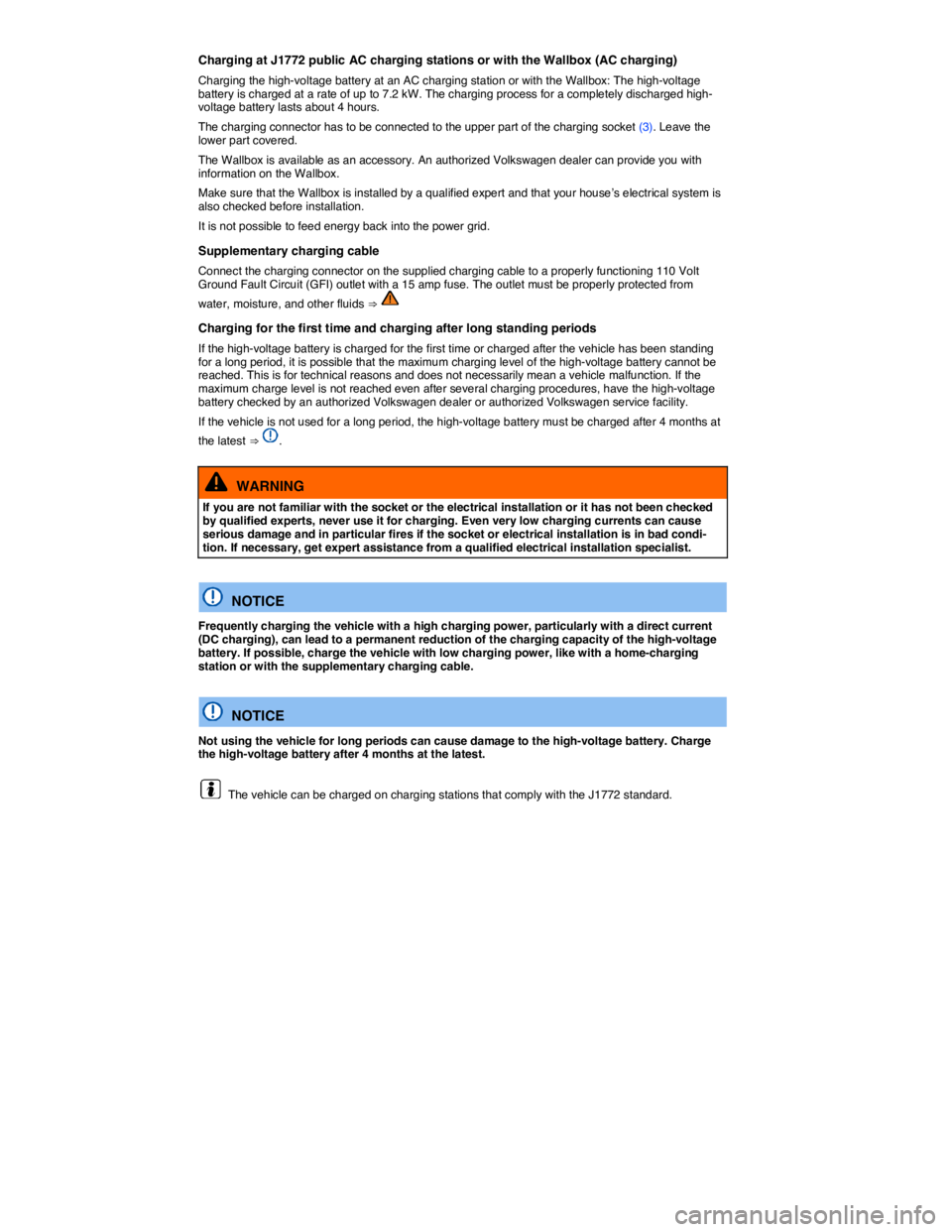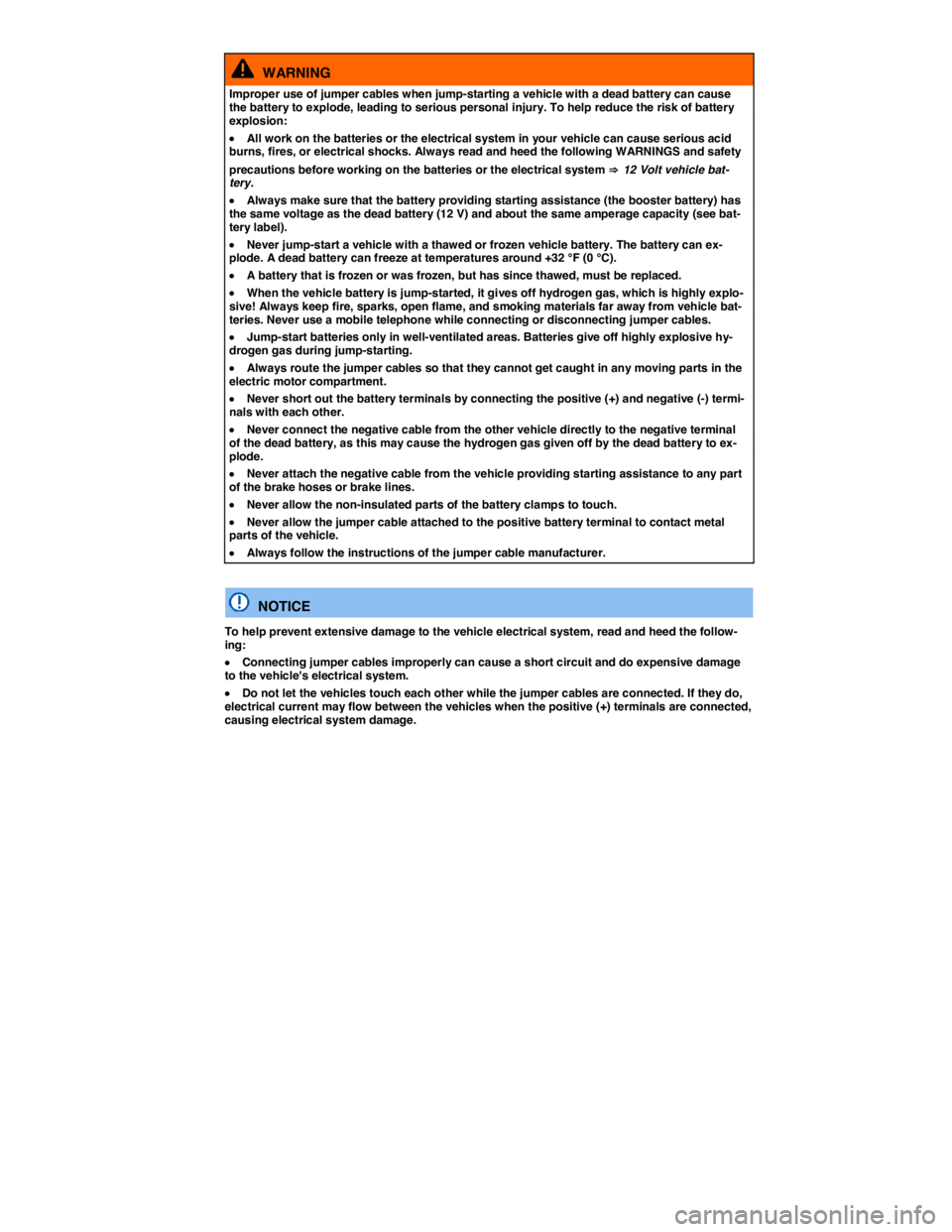battery capacity VOLKSWAGEN E-GOLF 2019 Owners Manual
[x] Cancel search | Manufacturer: VOLKSWAGEN, Model Year: 2019, Model line: E-GOLF, Model: VOLKSWAGEN E-GOLF 2019Pages: 394, PDF Size: 3.86 MB
Page 256 of 394

Charging at J1772 public AC charging stations or with the Wallbox (AC charging)
Charging the high-voltage battery at an AC charging station or with the Wallbox: The high-voltage battery is charged at a rate of up to 7.2 kW. The charging process for a completely discharged high-voltage battery lasts about 4 hours.
The charging connector has to be connected to the upper part of the charging socket (3). Leave the lower part covered.
The Wallbox is available as an accessory. An authorized Volkswagen dealer can provide you with information on the Wallbox.
Make sure that the Wallbox is installed by a qualified expert and that your house’s electrical system is also checked before installation.
It is not possible to feed energy back into the power grid.
Supplementary charging cable
Connect the charging connector on the supplied charging cable to a properly functioning 110 Volt Ground Fault Circuit (GFI) outlet with a 15 amp fuse. The outlet must be properly protected from
water, moisture, and other fluids ⇒
Charging for the first time and charging after long standing periods
If the high-voltage battery is charged for the first time or charged after the vehicle has been standing for a long period, it is possible that the maximum charging level of the high-voltage battery cannot be reached. This is for technical reasons and does not necessarily mean a vehicle malfunction. If the maximum charge level is not reached even after several charging procedures, have the high-voltage battery checked by an authorized Volkswagen dealer or authorized Volkswagen service facility.
If the vehicle is not used for a long period, the high-voltage battery must be charged after 4 months at
the latest ⇒ .
WARNING
If you are not familiar with the socket or the electrical installation or it has not been checked by qualified experts, never use it for charging. Even very low charging currents can cause serious damage and in particular fires if the socket or electrical installation is in bad condi-tion. If necessary, get expert assistance from a qualified electrical installation specialist.
NOTICE
Frequently charging the vehicle with a high charging power, particularly with a direct current (DC charging), can lead to a permanent reduction of the charging capacity of the high-voltage battery. If possible, charge the vehicle with low charging power, like with a home-charging station or with the supplementary charging cable.
NOTICE
Not using the vehicle for long periods can cause damage to the high-voltage battery. Charge the high-voltage battery after 4 months at the latest.
The vehicle can be charged on charging stations that comply with the J1772 standard.
Page 383 of 394

WARNING
Improper use of jumper cables when jump-starting a vehicle with a dead battery can cause the battery to explode, leading to serious personal injury. To help reduce the risk of battery explosion:
�x All work on the batteries or the electrical system in your vehicle can cause serious acid burns, fires, or electrical shocks. Always read and heed the following WARNINGS and safety
precautions before working on the batteries or the electrical system ⇒ 12 Volt vehicle bat-tery.
�x Always make sure that the battery providing starting assistance (the booster battery) has the same voltage as the dead battery (12 V) and about the same amperage capacity (see bat-tery label).
�x Never jump-start a vehicle with a thawed or frozen vehicle battery. The battery can ex-plode. A dead battery can freeze at temperatures around +32 °F (0 °C).
�x A battery that is frozen or was frozen, but has since thawed, must be replaced.
�x When the vehicle battery is jump-started, it gives off hydrogen gas, which is highly explo-sive! Always keep fire, sparks, open flame, and smoking materials far away from vehicle bat-teries. Never use a mobile telephone while connecting or disconnecting jumper cables.
�x Jump-start batteries only in well-ventilated areas. Batteries give off highly explosive hy-drogen gas during jump-starting.
�x Always route the jumper cables so that they cannot get caught in any moving parts in the electric motor compartment.
�x Never short out the battery terminals by connecting the positive (+) and negative (-) termi-nals with each other.
�x Never connect the negative cable from the other vehicle directly to the negative terminal of the dead battery, as this may cause the hydrogen gas given off by the dead battery to ex-plode.
�x Never attach the negative cable from the vehicle providing starting assistance to any part of the brake hoses or brake lines.
�x Never allow the non-insulated parts of the battery clamps to touch.
�x Never allow the jumper cable attached to the positive battery terminal to contact metal parts of the vehicle.
�x Always follow the instructions of the jumper cable manufacturer.
NOTICE
To help prevent extensive damage to the vehicle electrical system, read and heed the follow-ing:
�x Connecting jumper cables improperly can cause a short circuit and do expensive damage to the vehicle's electrical system.
�x Do not let the vehicles touch each other while the jumper cables are connected. If they do, electrical current may flow between the vehicles when the positive (+) terminals are connected, causing electrical system damage.
Page 386 of 394

WARNING
Improper use of jumper cables when jump-starting a vehicle with a dead battery can cause the battery to explode, leading to serious personal injury. To help reduce the risk of battery explosion:
�x All work on the batteries or the electrical system in your vehicle can cause serious acid burns, fires, or electrical shocks. Always read and heed the following WARNINGS and safety
precautions before working on the batteries or the electrical system ⇒ 12 Volt vehicle bat-tery.
�x Always wear proper eye protection. Never lean over the vehicle battery.
�x Attach the jumper cables in the correct order: first the positive cable, then the negative cable.
�x Never connect the negative cable from the vehicle providing starting assistance to parts of the brake hoses or brake lines.
�x Never allow the non-insulated parts of the battery clamps to touch.
�x Never allow the jumper cable attached to the positive battery terminal to contact metal parts of the vehicle.
�x Check the battery acid level indicator window on the vehicle battery. Use a flashlight, never a match, cigarette lighter, or other open flame. If you cannot see the color of the win-dow clearly, or if it is light yellow or colorless, do not jump-start the vehicle. Get expert assis-tance.
�x Avoid electrostatic discharge in the vicinity of the vehicle battery. Sparks may cause the hydrogen gas escaping from the vehicle battery to ignite.
�x Never jump-start a vehicle with a battery that is damaged or frozen or that was frozen and has thawed. The battery can explode. Replace the battery instead.
�x Always follow the instructions of the jumper cable manufacturer.
�x Always make sure that the battery providing starting assistance has the same voltage as the dead battery (12 V) and about the same capacity (see battery label).
�x Batteries give off explosive hydrogen gas. Always keep fire, sparks, open flame and smok-ing materials away from batteries.
�x Never connect the negative cable from the other vehicle directly to the negative terminal of the dead battery. The hydrogen gas from the battery is explosive.
�x Never short out the battery terminals by connecting the positive (+) and negative (-) termi-nals with each other.